Why ETP is important in chemical labs?
In terms of environmental impact, the chemical sector is important. This industry's wastewaters are typically powerful and may contain harmful contaminants.
Organic and inorganic materials are commonly found in various concentrations of chemical industrial wastes. Acids, bases, poisonous compounds, and matter with high biological oxygen demand, color, and low suspended solids content are all present. Many chemical compounds are poisonous, mutagenic, carcinogenic, or only partially biodegradable. Many treatment unit operations suffer from the usage of surfactants, emulsifiers, and petroleum hydrocarbons, which are employed in the chemical industry.
Effects of untreated chemicals
1. Environmental effects
(a) Nitrogen, phosphate, heavy metals, detergents, pesticides, and hydrocarbons are the most common chemical contaminants in wastewater.
(a) A low pH, induced by excessive nitrification and low wastewater alkalinity, is a major issue in some plants.
(c) Excess phosphorus in receiving waterways usually results in widespread algal development, which has severe consequences for nature conservation, recreation, and drinking water production.
2. Health Consequences
(a) Animal and human feces provide the majority of waterborne germs that cause human disease.
(a) The most common health risks connected with untreated drinking and recreational waters are diseases caused by bacteria, viruses, and protozoa.
(c) Many microbial pathogens found in wastewater can cause chronic diseases with long-term financial consequences, such as degenerative heart disease and stomach ulcers.
(d) Infants with methemoglobinemia (blue-baby disease) are frequently exposed to high-nitrate water.
The wastewatertreatment process in chemical industries
Biological, physical, and chemical approaches can all be used to treat effluent. Oxidative ponds, spray irrigation, well disposal, and incineration, among other methods, can be used to treat industrial wastewater.
1. Screening
The initial stage of the process is screening, which is where the influent water enters. This stage involves the employment of an oil skimmer, bar screens, and grit chambers. An oil skimmer is a machine that takes oil and grease from the water's surface. Another piece of equipment that is used as a filter to remove big solid objects such as plastic, paper, and other materials is the bar screen. Grit chambers are another type of mechanical filter that filters tiny solids such as stone and sand.
2. Coagulation and flocculation
It is a chemical reaction. To destabilize the suspended solid particles in the water, lime and aluminumsulfate are added with wastewater. When alum is combined with water, it aids in the faster bonding of solid particles and the formation of bigger solid particles. Lime aids in lowering the pH level. So that it may be easily removed or separated from effluent.
3. Clarifier
A clarifier is a device that sediments solids in a tank at the bottom. This can be accomplished either spontaneously or via the use of mechanical force. In the tank, the velocity of the influent is slowed to speed up the sedimentation of the solid.
There are two types of clarifiers: Primary and secondary
(a) To remove large solid particles, a primary clarifier is utilized. To eliminate tiny solid particles, secondary clarification is utilized.
(b) The secondary Clarifier tank is larger and has a longer influent detention time.
Finally, sludge is removed from the tank via a pit and a sludge plate.
4. Aeration
The next step in removing carbon dioxide (CO2) from wastewater is aeration. As small bubbles, oxygen is poured into wastewater. This procedure will aid in the removal of contaminants such as carbon dioxide, hydrogen sulfide, iron, and manganese from the air. The water will be less caustic as a result.
5. Osmosis (reverse osmosis)
Finally, wastewater is filtered via a membrane that allows only water to flow through while blocking waste particles and pollutants.
Thus treating effluents becomes a major part before the discharge of the untreated chemicals in waste water as it affects the environment directly, which poses a huge danger to our lives.
We at Netsol Water design and manufacture Effluent Treatment Plant which performs the task of effluent removal at great ease.
For more information, contact Netsol Water!




